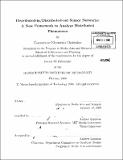| dc.contributor.advisor | Andrew Lippman. | en_US |
| dc.contributor.author | Christakos, Constantine Kleomenis, 1974- | en_US |
| dc.contributor.other | Massachusetts Institute of Technology. Dept. of Architecture. Program In Media Arts and Sciences | en_US |
| dc.date.accessioned | 2007-10-22T16:20:28Z | |
| dc.date.available | 2007-10-22T16:20:28Z | |
| dc.date.copyright | 2006 | en_US |
| dc.date.issued | 2006 | en_US |
| dc.identifier.uri | http://dspace.mit.edu/handle/1721.1/34183 | en_US |
| dc.identifier.uri | http://hdl.handle.net/1721.1/34183 | |
| dc.description | Thesis (Ph. D.)--Massachusetts Institute of Technology, School of Architecture and Planning, Program in Media Arts and Sciences, 2006. | en_US |
| dc.description | Includes bibliographical references (p. 155-165). | en_US |
| dc.description.abstract | With a new way of thinking about organizing sensor networks, we demonstrate that we can more easily deploy and program these networks to solve a variety of different problems. We describe sensor networks that can analyze and actuate distributed phenomena without a central coordinator. Previous implementations of sensor networks have approached the problem from the perspective of centralized reporting of distributed events. By contrast, we create a system that allows users to infer the global state from within the sensor network itself, rather than by accessing an outside, central middleware layer. This is accomplished via dynamic creation of clusters of nodes based on application or intent, rather than proximity. The data collected and returned by these clusters is returned directly to the inquirer at his current location. By creating this Distributed-in/Distributed-out (DiDo) system that bypasses a middleware layer, our networks have the principal advantage of being easily configurable and deployable. We show that a system with this structure can solve path problems in a random graph. These graph problems are directly applicable to real-life applications such as discovering escape routes for people in a building with changing pathways. We show that the system is scalable, as reconfiguration requires only local communication. | en_US |
| dc.description.abstract | (cont.) To test our assumptions, we build a suite of applications to create different deployment scenarios that model the physical world and set up simulations that allow us to measure performance. Finally, we create a set of simple primitives that serve as a high-level organizing protocol. These primitives can be used to solve different problems with distributed sensors, regardless of the underlying network protocols. The instructions provided by the sensors result in tangible performance improvements when the sensors' instructions are directed to agents within a simulated physical world. | en_US |
| dc.description.statementofresponsibility | by Constantine Kleomenis Christakos. | en_US |
| dc.format.extent | 165 p. | en_US |
| dc.language.iso | eng | en_US |
| dc.publisher | Massachusetts Institute of Technology | en_US |
| dc.rights | M.I.T. theses are protected by copyright. They may be viewed from this source for any purpose, but reproduction or distribution in any format is prohibited without written permission. See provided URL for inquiries about permission. | en_US |
| dc.rights.uri | http://dspace.mit.edu/handle/1721.1/34183 | en_US |
| dc.rights.uri | http://dspace.mit.edu/handle/1721.1/7582 | |
| dc.subject | Architecture. Program In Media Arts and Sciences | en_US |
| dc.title | Distributed-in/ distributed-out sensor networks : a new framework to analyze distributed phenomena | en_US |
| dc.type | Thesis | en_US |
| dc.description.degree | Ph.D. | en_US |
| dc.contributor.department | Program in Media Arts and Sciences (Massachusetts Institute of Technology) | |
| dc.identifier.oclc | 69421132 | en_US |
